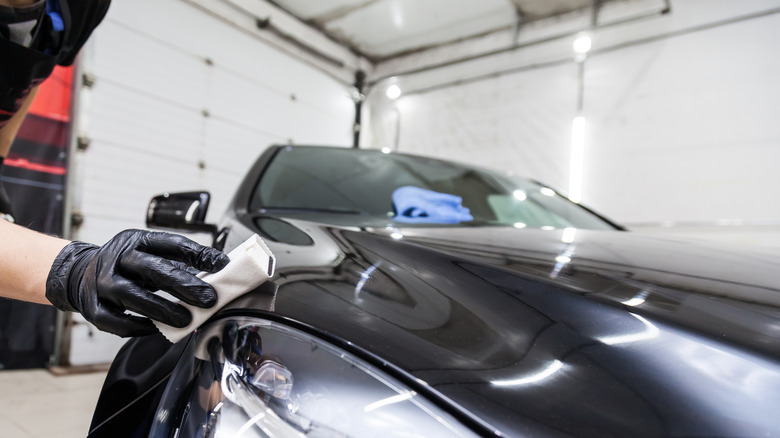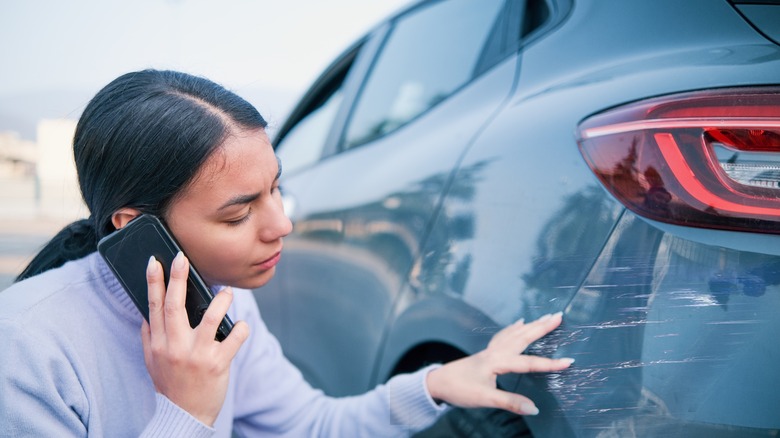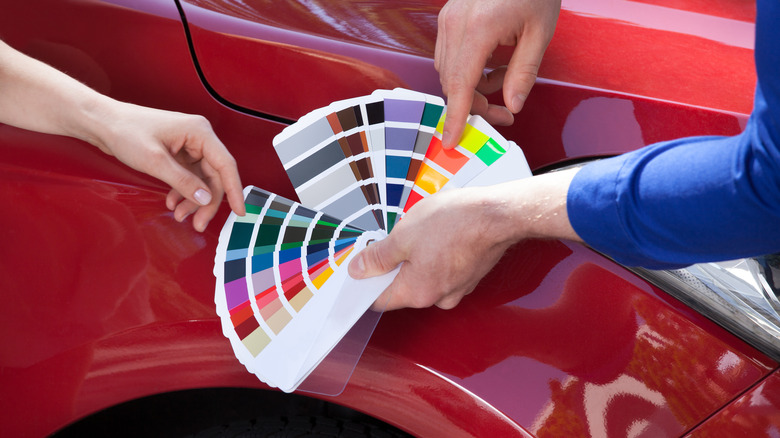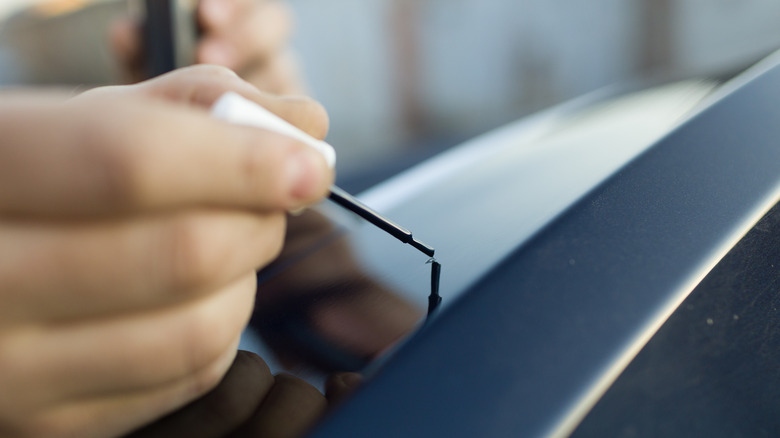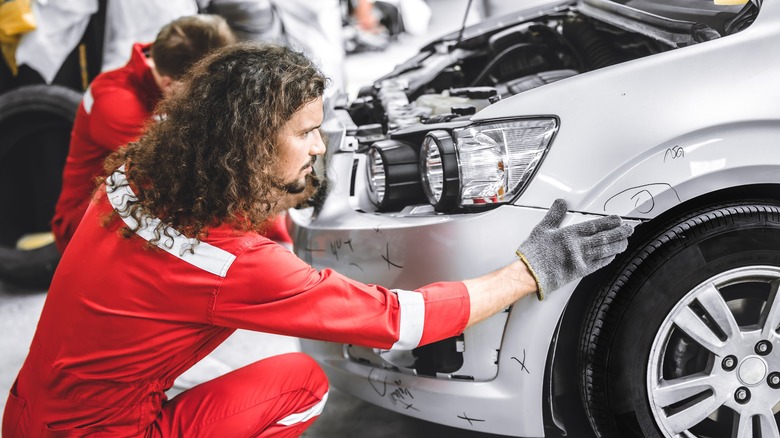What To Do If You Car Ends Up With Chipped Paint
We may receive a commission on purchases made from links.
Have you ever taken a moment to really look at your car and were horrified to find paint chips you've never seen before? You're not alone. Unfortunately, paint chips can happen to even the most careful car owners, and they can be due to honest mistakes, natural wear and tear, or even things that are beyond your control.
Cars experience chipped paint for a variety of reasons, such as the weather, minor accidents, the environment, harsh chemical materials, and even vandalism. Aside from being an eyesore, paint chips on your car can expose its metal to corrosion and lead to more serious issues like rust. So, if you find that your car paint is chipped, the first thing that you need to do is assess the overall damage to the vehicle.
To properly assess the chipped paint, gently clean the area first using soap, water, and a microfiber cloth. By removing the potential dirt or debris, you can also prepare your car for possible repair. While you're at it, make sure to avoid typical car cleaning mistakes to not add more damage to your vehicle, like washing under the hot sun or using the wrong kind of chemicals.
How to assess chipped car paint
In some cases, people can mistake scratches or scuffs for chipped paint. While scuffs are marks from another object or vehicle, scratches are when the car's coating has actual damage. However, a key difference between car scratches and paint chipping is that some scratches can be repaired with just buffing and a clear coat. On the other hand, paint chipping will always require some sort of repainting.
Stormwise shares that paint chips are often classified in three ways: small (smaller than a dime), medium (up to the size of a quarter), and large (larger than a quarter). Aside from this, it also shares that things like spreading, flaking, or rusting should also be taken into consideration during the damage assessment.
If you're not sure about the extent of the paint chip damage, a professional auto mechanic will also be able to tell you if it is only superficial or more serious. If you're not willing to pay them for the repair itself, you can also just consult for the correct color and ask for tips on how to avoid paint bubbling or dripping. If the chip is small enough, you're short on cash, or you just want to learn a new skill, you can definitely try to repair it at home. To do that, here are some things you should purchase ahead of time.
Buying your repair materials
Before you get started, you need to find the right paint color for the job. To find the right color, you can check the Safety Compliance Certification or door jamb label on the inside door of your vehicle (if your vehicle was built after 1983) or share your Vehicle Identification Number (VIN) with an attendant at your local car store. That being said, if you did modifications to your car, like changing the paint, you might need to approach the auto shop that did it for the color details.
Next, decide whether to get a touch-up paint pen, spray, or liquid tub. For smaller paint chips, the touch-up pen should be more than enough and can easily be stored in your car for emergencies. However, you'll need to get a spray or gallon for more serious and larger chips. For example, the Dupli-Color Perfect Match Premium Automotive Paint is available on Amazon in 206 colors and patterns with a rating of 4.2 over 34,000 reviews. Alternatively, some services like Automotive Touchup also let you order touch-up paint, which includes the base coat and clear coat, online.
While you're at it, you can also purchase an automotive primer, such as the Rust-Oleum 260510 Automotive 2-in-1 Filler & Sandable Primer ($7.88), which has 4.6 stars over 5000 reviews on Amazon. Some primers have additional benefits, like rust prevention as well. Similar to touch-up paint, you can find automotive primers in most auto shops or even retailers like Walmart.
Steps to repair car paint chips
Once the damaged area is clean and you've chosen the right paint chip repair kit for your needs, the next thing you should do is remove any rust. To do this, dab a Q-Tip with WD-40, swab it against the rusted area, and repeat the process until the Q-Tip returns clean. If you find that the rust is deep enough to damage your car's body, you may want to consider getting a professional opinion before proceeding because it may require some additional sanding.
After all the rust is gone, the next step is to apply automotive primer using the applicator brush that came with it. During this process, wait for the primer to dry completely before attempting anything else. Next, apply the touch-up paint in the form of a pen, spray, or brush.
To avoid unwanted bubbling or streaking, let the paint settle properly before adding another layer. To match the new paint with the rest of your vehicle, you may also have to polish and buff the rest of the car using a power buffer.
Once you're happy with the appearance, allow the paint to dry completely before checking if it will need another coat. Lastly, to add a new layer of protection from the elements, you can use wax, an essential car cleaning tool you probably have in your garage.
Keeping your car looking brand new
When it comes to repairing your car in any way, it's always best to also understand the limits of your skills. Should you realize that the damage is beyond your capacity to fix, hiring a professional to do the job can save you time, effort, and money in the long run.
Sometimes, you might not even notice when paint chips occur right away because they may have happened in a spot you don't normally notice. Knowing this, it's important to bring your car to its regular scheduled maintenance. Aside from paint chips, regular maintenance checks can help sound the alarm for symptoms of other potential problems in your car, like uneven tire wear.
In general, it's also best to avoid common mistakes car owners make that can ruin their vehicle's paint, like drying it too hard, putting objects on top of it, covering it with a car cover, and even just leaning on it unnecessarily. In doing so, you can keep your car's paint nicer for longer and maintain your vehicle's resale value in the process.
